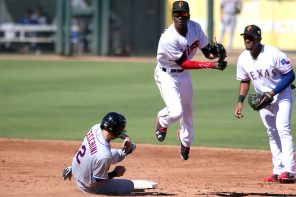Sean Reid-Foley
 |
|
Reid-Foley is a projectable future number three starter getting his first taste of Double-A action this year with the Fisher Cats in the Eastern League. While there is number-three upside, his command and control need to improve substantially for him to reach that ceiling. In six starts thus far this season he’s walked a total of 14 in 15 innings pitched. While the 8.4 BB/9 is an untenable number for a player with such high potential, it is early in the season and a small sample size, and it could well be just rough back-to-back outings hitting his spots. His 2016 BB/9 was a fringy 3.0 BB/9 across 115 innings at the Class A and High A levels, all while posting an impressive 10.1 SO/9 rate in that season, so I would expect the control issue to balance out as the season progresses and he eats more innings. Reid-Foley works from an abbreviated delivery that appears as being from the stretch, with a side-step delivery and compact arm action and above-average arm strength. His trouble repeating seems rooted in what’s appears be some limited athleticism in keeping the moving parts of his large frame working together through to an online finish. He had trouble working down in the strike zone and getting over his front side in this viewing. He’s got limited touch and feel with his three-pitch mix, but the quality of the overall stuff is there to turn over advanced lineups with regularity. Reid-Foley pitches with a plus fastball that sits 93 mph but he can get dial it up to 95 mph on occasion, and the offering has run bore and tailing action to both sides of the plate with projectable plus in-zone movement to justify the plus grade. His slider sat 83-to-86 mph with inconsistent break, break but when he didn’t muscle the pitch, it showed above-average tilt and depth with occasional plus action. His curveball was a 3/4’s breaker sitting 79-to-80 mph, and it blended too much with the slider look, but it showed enough spin action and break to be an above-average offering as well. Reid-Foley wasn’t great in this view, with the poor command and control standing out, but he has enough arm and raw stuff to project as a future number three starter with three above-average or better offerings, and a control profile that should ultimately settle in at average at maturity, but he still has a ways to go to develop the control through improved mechanics. |



